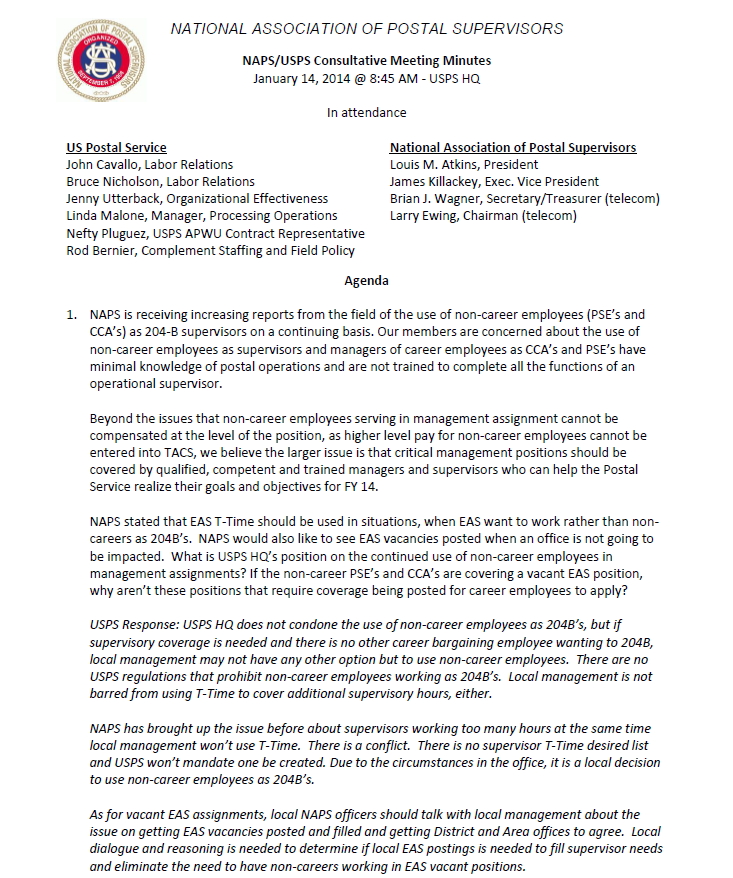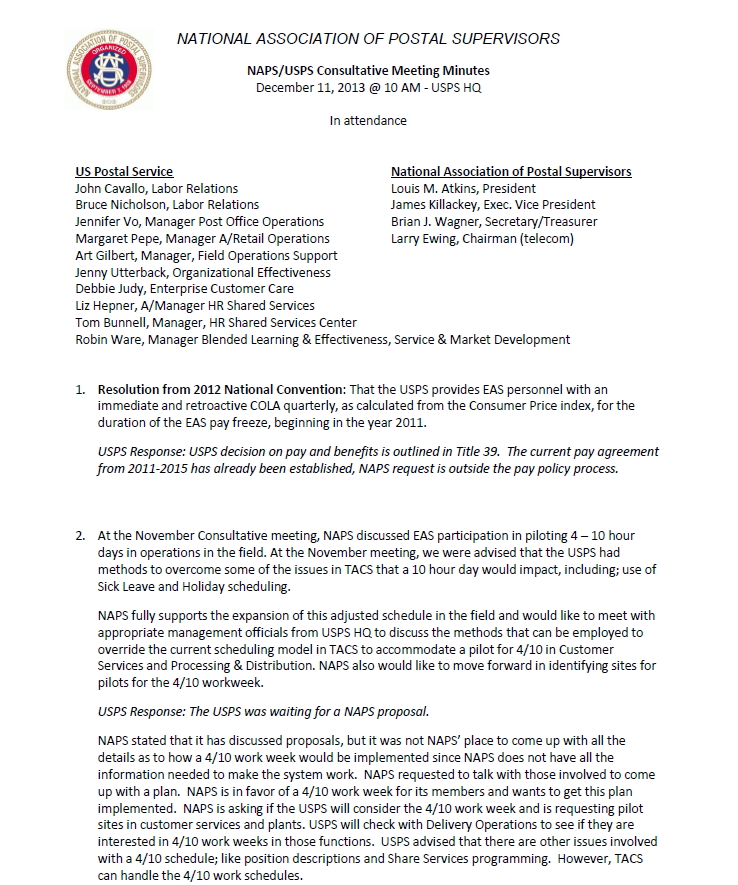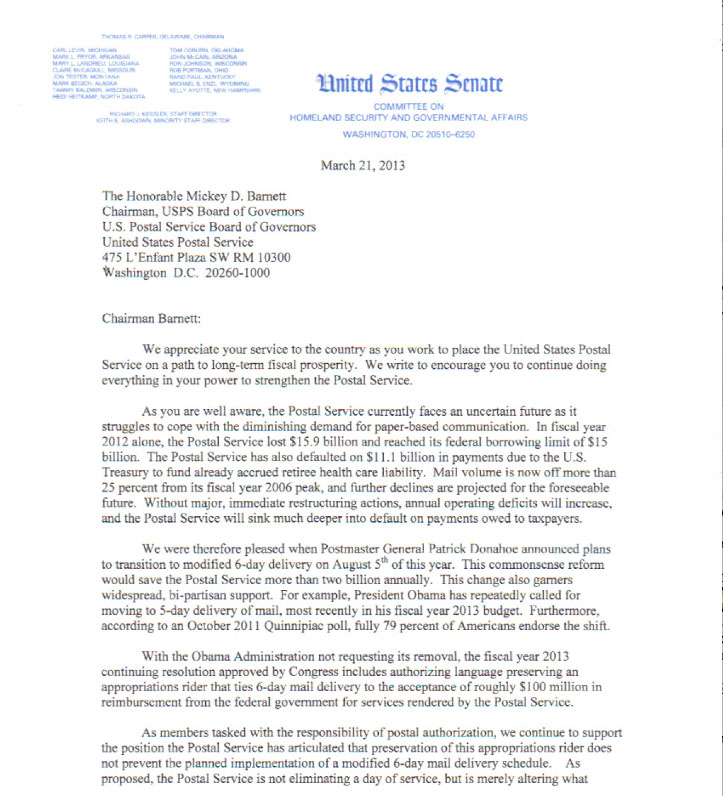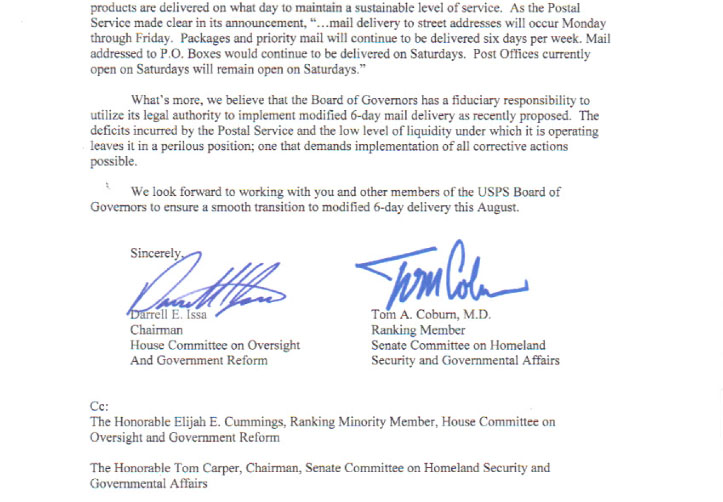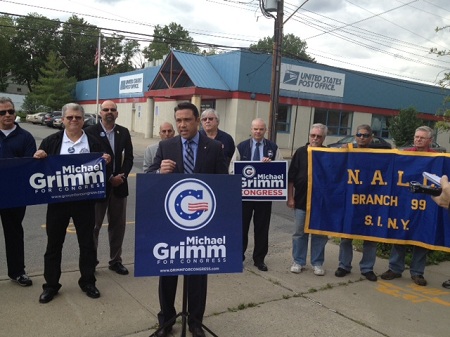August 14, 2013
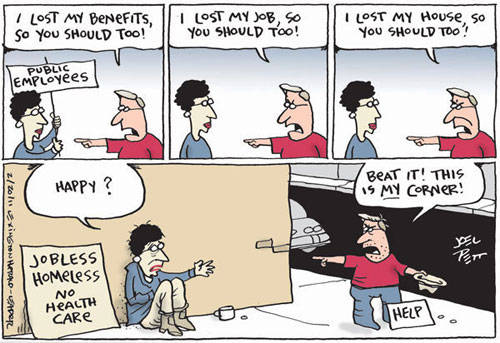
BY MARK JAMISON
What if the postal crisis we’ve read about over the last five years isn’t really about saving the Postal Service after all? What if the story really isn’t about an archaic Federal agency struggling to find a business plan in the face of technological change? Could the real story be much simpler than that?
Maybe the real story is about changing the basic relationship between employers and employees in the one sector of our economy where employees have been able to maintain decent wages and benefits.
Since 1980 wages have been stagnant for most people in the economy. Despite continued and steady growth in productivity, wages — especially for those in the bottom 90% — have lagged by a factor of seven against productivity. Since the early 1990’s, wages have essentially remained flat.
During this same period, traditional pensions have mostly disappeared and been replaced by 401Ks and other plans that shift the risk and responsibility for saving for retirement entirely to individual workers. As costs of healthcare and insurance premiums have skyrocketed, workers have been left to bear more of the burden for those costs.
Between wage stagnation and the decreasing value of benefit packages, average workers are much worse off than they were thirty years ago. During the same period, however, capital has done extremely well. That wealth gap became even more pronounced after the Great Recession.
Those at the top of the pyramid have recovered quite well, while everyone else has gone sideways or downhill. Corporate profits as a share of GDP are as high as they’ve been since 1929. Coincident with all of this is the fact that union membership as a percentage of the workforce has steadily decreased and is at its lowest level in more than a generation.
Attacking public employees
There is one partial exception to all this bad news and that is the public sector. While American business and the corporate sector have generally been at war with the American worker — shifting wealth and productivity gains upward rather than distributing them throughout the economy — public-sector workers have retained most of their benefits and have seen wages at least stay level with inflation.
Paying workers in the public sector a decent wage sets a bad example, so the corporate elite and the Right have mounted an all-out attack by pushing for cuts in the workforce and cuts in wages and benefits. One of the reasons unemployment has been so stubborn, even as the economy improves, is that job gains in the private sector have been offset by job cuts in the public sector. Head count at the Postal Service is down more than 200,000 since 2005, and there have been similar losses in Federal, State, and Local governments across the country. A generation of efforts by American business to erode the share of income flowing to labor has been successful, and now attention has been turned to the public sector.
The Right has celebrated this war against public employees just as it celebrated the war against working folks in general. The phony narrative of trickledown economics and tax cuts for the supposed job creators is a fundamental story of class warfare and redistribution of wealth upwards. It is the phoniest of narratives because in an economy that relies on middle-class demand for growth and profits, the stagnation of wages, the degradation of benefits, and the general attack on labor has hollowed out our middle-class.
As a number of economists have pointed out, our economy is stagnant because we lost over a trillion dollars of consumer demand, and there is no economic theory that allows for the replacement of that demand through more tax cuts for the wealthy or corporations.
An economy built on reducing wages and benefits to the lowest levels possible may lead to Wal-Mart prices and higher corporate profits, but it is a fool’s bargain that leads to low wage jobs that cannot sustain sufficient levels of demand to support the economy as a whole. As the benefits of the economy increasingly accrue to a smaller and smaller group, it becomes clear that the wealthiest one percent cannot consume enough to sustain growth and general prosperity.
Whether or not it’s ultimately a successful strategy, the fact of the matter is that for the last generation the model has been to suppress wages and benefits in pursuit of higher profits. And that brings us to the Postal Service.
Exploiting a manufactured crisis
The crisis that confronts the Postal Service is largely manufactured. About 80% of the accumulated losses of the past six years can be directly attributed to the Retiree Health Benefit Fund (RHBF) payments mandated by the PAEA. Much of the initial volume losses incurred in 2007 and 2008 could be attributed to the financial collapse and the ensuing Great Recession. While it’s true that postal systems are challenged by the Internet specifically and technological change more generally, it’s also true that those challenges are not insurmountable.
It’s hard to argue a counterfactual, but there’s a fair amount of evidence to demonstrate that the steps PMG Donahoe has taken to cut costs — combined with a barrage of negative reporting and a sense of perpetual crisis — have driven a good deal of first class mail out of the system. Individuals and businesses are moving to the Internet faster than they might have, largely out of fear that the mail system will collapse. During several PRC change-of-service cases (the N dockets), evidence has been presented to show that changes in service and degradation of the system can lead to significant drops in volume and revenue.
The losses that began in 2007 didn’t have to be as bad as they were. There were moderate steps that could have been taken to mitigate the declining volumes. Certainly modifying or suspending the RHBF would have made the case simpler. Unfortunately, it served the interests of those who support our current economic models and trends to make the situation as bad as possible.
Those who formulated and implemented the scorched-earth policies that kept the Postal Service in crisis had two basic aims: privatization of public services (i.e., the transfer of public revenue and assets to the private sector) and, perhaps more importantly, the destruction of a unionized workforce and the successful benefit programs those workers depend on.
Breeding envy and resentment
Over the years, we’ve seen a number of efforts to argue that postal revenues ought to be privatized. From the minions of Pete Peterson working in the guise of NAPA to the industry lobbyists of PostCom and various alliances like the GCA, we’ve heard two arguments — privatize more of the system and reduce the costs of postal labor. It’s not hard to see why those in the corporate world would be motivated to get their hands on the $65 billion in postal revenues or possibly even the more than $300 billion in employee benefit programs – those transfers would very lucrative.
More important, there are ideologues as well as those in industry who would love nothing more than to see Federal employee benefit programs eroded or even destroyed. One of their main strategies is divide-and-conquer — sow jealousy and discontent among the populace. The message is simple: “Look at those rich teachers, firemen, postal workers, and all the benefits and salaries they get. And hey, let’s not forget that those benefits and salaries are paid for with your tax dollars.”
I suppose it’s human nature for many folks to have a knee-jerk reaction to that sort of pandering propaganda and say, “Yeah, why do they get paid so much? Why should I have to pay them?” It’s also human nature to think that the other guy doesn’t work as hard as you do or that he received some sort of insider deal to get that cushy public job (never mind that in most cases those jobs are open to anyone choosing to take a civil service test or go to school to get the required training to become a teacher).
Still, I don’t understand why more folks don’t have a sort of “never mind the man behind the curtain moment” and ask, “Hey, why doesn’t my company have a defined benefit pension anymore?” or “How come the CEO suddenly makes so much?” or “What did the hedge fund accomplish by driving us into bankruptcy?”
After the financial crisis, people seemed more concerned that the guy next door might undeservedly get a little break on his mortgage principle rather than that the banks and financial institutions that caused the train wreck not only walked away unscathed but returned to record profits. It’s the same sort of mindset that finds a 1% fraud rate in the food stamp program more horrifying than the fact that large agribusiness and gentlemen farmers get billions in subsidies even when they’re already very profitable. I suppose it’s the American way to elbow your way in front of Mr. Jones next door while dreaming of bootstrapping yourself into hedge fund wealth.
The same people who screamed that bailing out General Motors was terrible because we shredded the contracts of the bondholders (in America contracts are sacrosanct) seem to have no problem arguing that contractual promises to Detroit’s public employees ought to be trampled without remorse because the average pension of $19,000 a year is too much for a public employee, even though those folks don’t get Social Security. In America, we have a fundamental respect for property rights, so our word is our bond and a contract is a contract – unless, of course, it’s a union contract. In that case, it was probably a forcibly-arrived-at deal with the devil, and there’s no reason to respect it.
Undermining model programs
For the last forty years, senior postal management has said, in good times and bad, that in order for the Postal Service to survive and run efficiently they must have more control over their workforce. Never mind that postal workers don’t have access to the strike as a means of persuasion. Postal contracts are either negotiated, in which case they are mutually agreed upon (key word mutually) as beneficial, or they are concluded through binding arbitration, in which case each side has the opportunity to martial its arguments and resources to create the best case for its interests. It’s a fair and open forum so if your arguments don’t prevail maybe it’s because they just weren’t very good arguments.
For decades now, the prevailing view has been to put shareholder interest above and beyond all other interests. American business has seen labor as merely a cost to be minimized. Never mind that a poorly paid workforce can’t buy the goods and services that American business seeks to produce.
So the traditional defined-benefit pension was replaced with a defined-contribution program, which transferred the risk from the group to the individual and created a huge opportunity for the financial industry to reap greater profits by charging fees to manage each person’s retirement fund. (Another premise of American business has become “there are no customers, only revenue sources ripe for fee extraction.”)
Patrick Donahoe says that the only way for the Postal Service to survive is to take employees out of the Federal benefit systems for both health and retirement. He claims that he can provide postal employees with the same quality of benefits that they now receive under those systems. There is no possible scenario in which he can do that, but that really isn’t the point.
What folks like Darrell Issa and right-wing think-tanks and ideologues of the “you’re on your own” stripe really want is to undermine Federal benefit systems. These programs are a shining example of the good that government can do, and that’s exactly why they need to be eliminated or grievously weakened.
Putting risk on the individual
That’s the goal, pure and simple — undermine the sorts of employee benefit systems that act as a good example and remove the temptation for people in every sector of the economy to believe that employers ought to make better bargains with their employees. Undermine Federal retirement and healthcare systems that work well and are well funded, and other public employee systems begin to fail as well. The goal, as it has been for at least the last thirty years, is to seek to find the least common denominator, to pay people as cheaply as possible and to remove systems that provide people with a fair amount of reward, hope, and security.
The Federal Employee Retirement System (FERS) covers 2.6 millionworkers, so removing 500,000 postal workers from the system won’t destroy it, but it would set a very destructive example. PMG Donahoe cannot replace the FERS system with anything nearly as effective. He would move employees to a 401K-type system that shifts all of the risk of investment onto the individual. Recent studies have shown that 401K plans have not been nearly as effective at providing retirement savings as other sorts of pension plans. What they have been good at is creating fees for the financial industry.
While a 401K component to a retirement plan is a useful tool in placing responsibility for saving on the individual and addressing moral hazard and free rider issues, it serves that function best as part of the three legged stool that is FERS – a defined benefit, a defined contribution, and Social Security.
PMG Donahoe would create a plan that relies solely on employee contributions, supplemented by questionable and certainly not guaranteed employer contributions. Seniors today are less and less secure because of the shift to these sorts of programs. While large institutions, hedge funds, and banks may have recovered from the machinations of the stock market created by the crisis, individuals have not done so well.
Emulating the private sector
When it comes to health care, the dirty little secret is that the solution to less costly healthcare for Federal employees generally and postal employees specifically has been around for thirty years. In 1984 changes were made in Social Security and Medicare to shore up those plans for the future. Despite the dire warnings offered by those whose ultimate goal is to turn back the clock to a time before we had a solid social safety net, both of those systems are in generally good actuarial shape. Under current scenarios, Social Security can pay full benefits through about 2035 and 75% thereafter; a few tweaks like indexing the wages subject to the payroll tax would extend that timeline significantly.
The problems with Medicare are really problems with medical costs generally. We pay nearly twice as much per capita as any other developed nation for medical care and receive results that, at best, put us in the middle of the pack. Lately the cost curve has been bending down, and CBO forecasts for the future of Medicare look much better.
Those issues have been litigated endlessly but the important point to note is that the 1984 changes left a gaping hole. Federal employees and their agencies paid into Medicare, but employees and retirees reaching the age of 65 were not required to sign up for Medicare Part B. This meant that those in the FEHB system continued to use their FEHB coverage as the primary payer for Part B charges rather than having their FEHB policy act as secondary or supplemental coverage.
The organizations representing Federal employees, including postal unions, have been shortsighted in protesting a change that would require Federal employees and retirees to take Medicare Part B and use their FEHB program as a supplemental. Some argue that the switch would penalize older retirees because there is a penalty for each year that one delays in signing up for Part B. That could be easily and fairly handled by creating a grace period following any new requirement.
Yes, the addition of Part B premiums would mean that retirees paid more in premiums, but with the change and offerings of supplemental policies it is likely that overall premiums in the system would come down and in any event the increases would be small and the shift would be fair.
The FEHB program is one of the best examples of a working insurance exchange around. Its administrative costs may not be as low as Medicare’s, but they are still low. If the Affordable Care Act had had a public option, FEHB would have been the best alternative to Medicare for all (that may be why some might want the program to fail).
Pat Donahoe claims he can build a system that works better than FEHB. He can’t. After reviewing his proposal, the GAO and even the conservative AEI questioned his ability to design a system as effective as FEHB, with the same low administrative costs and levels of coverage. Mr. Donahoe’s plan is pie in the sky, but it does serve one very effective purpose. Taking postal workers out of Federal retirement systems might indirectly hurt the system by setting a bad example, but taking postal workers out of FEHB would cause significant harm to the system and probably cause premiums to rise.
The stated goal may be to create a cheaper system for the Postal Service, but the primary purpose and the almost certain result of Donahoe’s proposals would be to weaken solid and reasonable employee benefit systems. It’s what the private sector has been doing for years, and if nothing else, Donahoe wants to emulate the private sector and be more businesslike. It’s the American way — reduce wages and benefits, profits to capital, a race to the bottom for working folks.
Leaving FEHB behind
Creating the Retiree Health Benefit Fund (RHBF) and fully funding it in ten years was never really necessary. It was done as a budget-scoring mechanism to deal with the fact that in 2002 the Office of Personnel Management had determined that the Postal Service was on track to overfund one of its pension plans (CSRS) by over $70 billion. Decreasing the pension payments would have increased the federal deficit by over $40 billion over a ten-year period, so Congress came up with prefunding retiree health care to keep the money flowing into the Treasury.
Sure, there were those who argued that the Postal Service faced a long-term liability for retiree healthcare. There’s no question that it would be prudent to put aside money for that future obligation, even though retiree premiums have been paid out of current revenues for years. The thing is that the adjustment to requiring those over 65 to participate in the Medicare programs that both they and the employer had paid for would have mostly solved the problem and made RHBF, at least the way it was enacted, wholly unnecessary.
Employee organizations across the government will likely reject any call for their members to pay more, and requiring the use of Medicare would almost certainly cost the average person over 65 a bit more. But paying a bit more to save a system that works well and is a good example of a health benefit system and doing so to close what, by any measure is a loophole, is both sensible and reasonable.
Over the years some of the postal unions have dabbled with the idea of taking their members out of FEHB. Currently both the NALC and the APWU are entertaining suggestions to do just that. They can fool themselves into believing that a smaller pool of employees can create a better system, but at the least they would have to concede that any system they create would have to include a requirement that those over 65 use Medicare as a first payer and the pool policy as a supplemental.
Breaking the unions, undermining good programs
From the beginning, the management of the Postal Service has used the deficits created by the RHBF to heighten and magnify the financial crisis. The various employee associations argued this with some degree of effectiveness, but other issues — like the supposed pension overpayments endorsed by the Segal report — clouded the narrative.
The fact was and still remains that the postal financial crisis has been used primarily as a means of breaking the union workforce and undermining Federal benefit systems while also undermining public infrastructure. It is a course consistent with the direction of American business over the last thirty years or more, and it’s worked.
Early on some folks proposed two immediate concessions that postal employees ought to make. The first was the Medicare participation and the second was equalization of postal health premiums with other Federal employees. The second would have yielded an immediate savings to the Postal Service of between $600 and $700 million per year. Yes, it would have been a tough concession. Unions exist to bargain for their members’ advantage, but in this case there are good arguments that if postal workers are to benefit from participation in Federal benefit plans, then they ought to share the benefits and burdens like all Federal employees.
Had the employee organizations offered those solutions early on, they would have destroyed any arguments that supported RHBF. It took at least a couple of years for the media to pick up on the narrative, but by that time the damage was done. The losses piled up, volume fled the system, and most of America was convinced that the story was simple without much nuance.
In the end the APWU signed one of the worst negotiated agreements in the history of American labor. The other unions faced arbitrations that used the APWU agreement as a model. The result was a give back of wages and benefits that had been won over forty years and the creation of a part-time, cheaply paid workforce with second-tier benefits. The postmaster organizations added to the debacle by trying to preserve things like convention leave while ultimately agreeing to keep silent while the Postal Service perpetrated POStPlan, an effort that will likely result in the closure of thousands of post offices, the loss of thousands of jobs, and a great loss in service and effectiveness for rural communities across the United States.
Destroying the middle class
Anyone who believes that what is happening to the Postal Service is the inevitable result of structural changes to the economy or technological changes within the communications industry is simply blind to the class warfare that the American worker and the American middle-class have been subjected to for the last forty years.
This postal crisis is not about changing technologies. It isn’t about an unsuitable business model. It isn’t even about maintaining low rates for industry — we’ve had some of the lowest postal rates in the world before and during this crisis. No, this is first and foremost about breaking the back of one of the more successful labor sectors in the economy.
This is about ensuring that good benefit and compensation systems are destroyed because our economy no longer exists as a marketplace where consumers, workers, and business coexist and share in the benefits of mutual labors. This is about class warfare and the destruction of the American middle-class, the usurpation of the economy by the few at the expense of the many.
[Mr. Jamison is a retired postmaster and a regular contributor to Save the Post Office; his articles are archived here. He can be reached at [email protected].]
Sources:
“Labor’s Declining Share of Income and Rising Inequality,” Economist’s View, Sept. 25, 2012
Corporate Profits as a Share of GDP, Economist’s View, May 6, 2013
Cumulative change in hourly productivity, real average hourly compensation, and median compensation, 1973–2011, State of Working America

